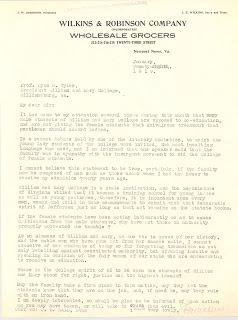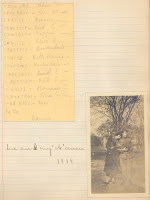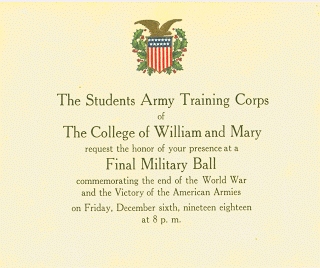January 30, 2009
January 30, 1919: The First Semester of Coeducation Comes to a Close
January 29, 2009
January 29, 1919: The Flat Hat Returns
January 28, 2009
January 28, 1919: A Concerned Citizen Speaks out for the Marys
"There was a certain resentment [toward coeducation] among the alumni and there were a lot of the students -- it would not have been fashionable for them to say that they approved of coeducation, but they weren't at all unfriendly to the girls. But it was fashionable to feel that this was a man's world and that William and Mary was a man's college, and they were possibly a little condescending in their attitude toward us, but as I remember, the students who were actually in college were very friendly. As I told you the other day, the war [World War I] was on, and everyone was thinking of the war so much more than they were of women's rights and coeducation that we didn't run into -- I don't remember any unpleasant attitude on the part of the men in general. I'm sure you read this little write-up they had this year -- "The Petticoat Invasion" or something like that. The only thing I really remember: there was this one preministerial student who was very much opposed -- I don't exactly remember why -- a young man named Wicker. He went on and studied for the ministry; I don't know what his attitude in later life was, but at that time he felt that this was just all wrong. He felt quite intensely on the subject that women should not go to William and Mary. And at that time they had two literary societies and debates were the big thing; just about every month they had a debate in one of the literary societies. They decided to have a debate pro and con on coeducation. And someone I think with a strong sense of humor put Mr.Wicker on to support coeducation. They just put him on that side. The two literary societies didn't have any women as members but we were invited to that particular meeting. I didn't go; I wish I had. A number of them went, and Mr. Wicker when it came his turn to give his section of the debate in favor of coeducation, stood up and said as there was nothing to be said in favor of coeducation he would have to explain why he couldn't support it, and he launched into a very violent attack on coeducation. Some of the girls were rather upset by it, others were very much amused, and the student body in general had a grand time. They just thought it was a grand, big joke, but there were a few of the girls who felt quite upset and embarrassed about having gone. This was just the age when the flapper was appearing, and he drew a terrible picture of the awful flapper and the awful influence she was on the male students and how her short dresses were disrupting the morals of the world and that the students weren't able to keep their minds on their studies because of the horrible women who were parading around in these short skirts. And the skirts actually -- they wore high shoes at the time and the skirts were actually an inch or two above the top of the high shoes, which was supposed to be just terrible. It [the debate] was a very exciting event but that is really the only incident I remember. There were a lot of students whose individual opinion was that women didn't belong in college, that they didn't need higher education, that this was sort of ridiculous -- but they didn't carry it over to being unfriendly at all. They dated the girls if they liked the girls and they didn't date them if they didn't and that was it."

News of the debate spread quickly. Within a week, alum J.E. Wilkins wrote to President Lyon G. Tyler, appalled that any student of William and Mary would "[offer] insults and [speak] in derision of the fair women of our state who are endeavoring to receive and education." Moreover, he found it disgraceful that the women might behave in such a manner to provoke criticism and yet go unchecked by the faculty. From this perspective, coeducation was degrading the rules of conduct between men and women, leading to a break down of society on campus. What Wilkins had in mind to fix the situation is open to interpretation - whether ending the experiment in coeducation or simply enforcing common courtesy between the sexes. No other major incidents were reported and "that act remain[ed] on the Statute books."
Copy of letter from J.E. Wilkins to President Tyler, January 28, 1919. From the records of Lyon G. Tyler. Click to enlarge image.
The above oral history excerpt is from an interview with Emily Williams, as part of an oral history project of the College conducted between 1974 and 1976. A longer excerpt of Kimbrough's interview may be found online. Complete transcripts of the project and records of Lyon G. Tyler are available in the Special Collections Research Center.
January 11, 2009
January 11, 1919: "Exclusive Party at Tyler Hall"
A calendar of events in The Colonial Echo gives this enigmatic entry for January 11: "Exclusive party at Tyler Hall. Gent's suits and shoulder bars are borrowed, and the shades are drawn tight???? Skulking figures slink down Gloucester Street. Every man a girl and every girl a lady." The event? The Manless Dance. While some female students opted to wear their normal clothing, the point of the dance was for the women to dress like men. They borrowed suits and uniforms from male friends in order to
 look as masculine as possible. The dance was such a success that it became an annual event among the women students.
look as masculine as possible. The dance was such a success that it became an annual event among the women students.Editions of The Colonial Echo and Catherine Dennis' scrapbook are available in the Special Collections Research Center.
January 5, 2009
January 5, 1919: New Year, Same Classes
December 20, 2008
December 1918: Winter Break
December 6, 2008
December 6, 1918: SATC Military Ball
 Less than a month after the end of World War I, the Students' Army Training Corps (SATC) at William and Mary disbanded. On December 6, 1918, family, friends, students, and faculty were invited to an open house at the Corps' barracks and then to a parade review and ceremony at the athletic field. The day ended with the SATC Final Military Ball, "commemorating the end of the World War and the victory of the American Armies." The Virginia Gazette referred to the dance as a "celebration of the S.A.T.C. [that] will long be remembered by William and Mary boys, and will will mark a unique period in the history of the old college."
Less than a month after the end of World War I, the Students' Army Training Corps (SATC) at William and Mary disbanded. On December 6, 1918, family, friends, students, and faculty were invited to an open house at the Corps' barracks and then to a parade review and ceremony at the athletic field. The day ended with the SATC Final Military Ball, "commemorating the end of the World War and the victory of the American Armies." The Virginia Gazette referred to the dance as a "celebration of the S.A.T.C. [that] will long be remembered by William and Mary boys, and will will mark a unique period in the history of the old college."[...] the greatest part of the celebration remained for the evening, when the formal military ball, the principal social affair of the military organization, was held in the Mess Hall. It had been planned a considerable time in advance, and all members of the command attended and brought partners. In addition to the young ladies of the college, many attended from Williamsburg, Richmond, Norfolk, Washington and other cities. Many of the soldiers had their sweethearts from a distance to attend. The whole affair was so well organized and conducted that a more successful one would have been rare indeed. The walls, chandeliers, trimmings, and furnishings of the large hall were lavishly decorated with the national colors in various designs of presentment, all of which was pleasingly illuminated by the brilliant colored lights.
The guests assembled at 8 o’clock, the ladies wearing the latest creations of evening dress and the men all wearing their dress military uniforms. [...]
At 10 o’clock there was an intermission of a few minutes, during which a neat little cap, called the “Liberty Cap” by the guests designed and made especially for the occasion, was issued to each lady present, and was worn by her during the remainder of the evening.
Not the least element in the evening’s jocund entertainment was the bounteous supply of punch and other refreshments. May the reader not inquire what the punch was made of. [...]
The final dance was announced by the bugle call for taps and came to a close exactly at 1:25 o’clock in the morning. The out-of-town guests were entertained by friends at the college and in Williamsburg.
This post was composed by Kate Hill.
For additional information about the first women students at the College of William and Mary see: When Mary Entered with her Brother William: Women at the College of William and Mary, 1918-1945 by Laura F. Parrish; "The Petticoat Invasion": Women at the College of William and Mary, 1918-1945; The Martha Barksdale Papers; and the Women at the College of William and Mary page on the Special Collections Research Center Wiki.


